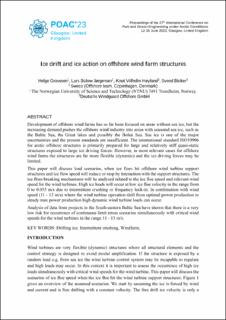Ice drift and ice action on offshore wind farm structures
Peer reviewed, Journal article
Published version
Permanent lenke
https://hdl.handle.net/11250/3120157Utgivelsesdato
2023Metadata
Vis full innførselSamlinger
Sammendrag
Development of offshore wind farms has so far been focused on areas without sea ice, but the increasing demand pushes the offshore wind industry into areas with seasonal sea ice, such as the Baltic Sea, the Great lakes and possibly the Bohai Sea. Sea ice is one of the major uncertainties and the present standards are insufficient. The international standard ISO19906 for arctic offshore structures is primarily prepared for large and relatively stiff quasi-static structures exposed to large ice driving forces. However, in most relevant cases for offshore wind farms the structures are far more flexible (dynamic) and the ice driving forces may be limited.
This paper will discuss load scenarios, when ice floes hit offshore wind turbine support structures and ice flow speed will reduce or stop by interaction with the support structures. The ice floes breaking mechanisms will be analysed related to the ice floe speed and relevant wind speed for the wind turbines. High ice loads will occur at low ice floe velocity in the range from 0 to 0.055 m/s due to intermittent crushing or frequency lock-in. In combination with wind speed (11 - 13 m/s) where the wind turbine operation shift from optimal power production to steady max power production high dynamic wind turbine loads can occur.
Analysis of data from projects in the South-eastern Baltic Sea have shown that there is a very low risk for occurrence of continuous limit stress scenarios simultaneously with critical wind speeds for the wind turbines in the range 11 - 13 m/s.
